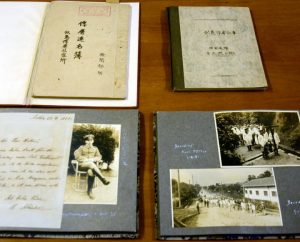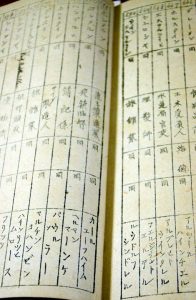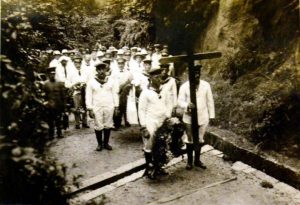Documents left by German interpreter vividly show the life of prisoners of war at internment camp on Ninoshima Island
Oct. 25, 2022
Researchers say that the documents are “first rate.”
by Kei Kinugawa, Staff Writer
New documents which recorded the life of the German prisoners of war (POWs) at the internment camp on Ninoshima Island (now part of Minami Ward) during the First World War have been found. Eiji Takebayashi, an associate professor at Hiroshima University of Economics who specializes in the history of exchange between Japan and Germany, obtained the register, notebooks and photograph albums left by an interpreter one century after the closure of the facility in 1920. Researchers value them highly as “first rate documents which tell a picture of the POWs’ personalities and their interaction with Japanese.”
The documents were recorded and kept by Senzaburo Aoki, who worked as a German interpreter in Ninoshima Island at that time. Professor Takebayashi, who studies the history of Hiroshima as a military city, got the material through an antiquarian bookshop. Mr. Aoki had not been known even among the researchers who are familiar with the POWs. According to Shuichi, 80, Mr. Aoki’s nephew who lives in Tokyo, Germans visited his uncle’s parents’ home in Nagoya, which carried chemical dye back then. Shuichi infers that the “Japanese Army might have summoned his uncle as an interpreter because he had learned German at a school of foreign languages in Tokyo.”
The register labeled “For Censor Department” contains names of the 545 POWs written in the katakana syllabary, with a military unit to which each of them belonged. Their occupations before joining the military vary; judge, shipbuilder, beer brewer, and others. The occupation field for Karl Juchheim, who first baked baumkuchen in Japan, is filled in as confectionery.
In the B5 size notebook labeled “Statement of facts about the POWs of Ninoshima Island” on the cover, there are memos about things such as menus and the way to communicate discipline. Mr. Aoki apparently used the notebook to make notes. There is also a speech, written both in Japanese and German, which seems to have been made by the head of the internment camp the day before the POWs were set free (on December 25, 1919), in which words of appreciation for staying at the internment camp for a long time were expressed. Professor Takebayashi says, “We can see that Japan, which was trying to join the first-rate countries, treated the POWs humanely by observing international law. He might also have become attached to them.”
In the two photograph albums, there are portraits of the POWs, pictures of the facility in full view, activities of the drama club and the chorus club, and a funeral conducted for a POW who died while being held in the internment camp. A letter from one of the POWs who returned to Germany was also attached. There is also a picture of Mr. Aoki with the Germans, which was taken in Miyajima on the day the POWs were set free, showing that they had a great trust in him.
Takehiko Seto, a professor emeritus at Kochi University who is knowledgeable about the camps for German POWs that were set up across the country including in Tokushima and Oita, points out, “I have never seen a register created by each camp. They are the valuable documents to understand how POWs, who were recognized by their names and not numbers, lived in a foreign land.” Professor Takebayashi said enthusiastically, “I would like to fill voids in the history of Hiroshima by making the most of the discovered material.”
Keyword
Internment camp on Ninoshima Island
Established on February 19, 1917, to accommodate about 550 German prisoners of war (POWs) who were relocated from the internment camp in Osaka when it was closed. They were among those who were brought to Japan from Qingdao, China, which was a German territory at that time. The internment camp on Ninoshima Island was closed on April 1, 1920. The POWs interacted with the students at Hiroshima Higher Normal School (now Hiroshima University) through succor. In March 1919, an exhibition of specialty items produced by German POWs was held at the Hiroshima Commercial Exhibition Hall (now known as the Atomic Bomb Dome), to which Karl Juchheim sent baumkuchen.
(Originally published on October 25, 2022)










